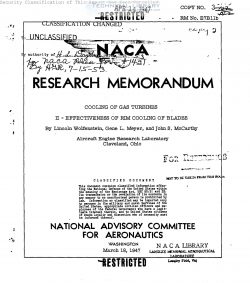naca-rm-e7b11b
- Version
- 62 Downloads
- 1.64 MB File Size
- 1 File Count
- April 21, 2017 Create Date
- April 21, 2017 Last Updated
National Advisory Committee for Aeronautics, Research Memorandum - Cooling of Gas Turbines - II - Effectiveness of Rim Cooling of Blades

An analysis is presented of rim cooling of gas-turbine blades;
that is, reducing the temperature at the base of the blade (wheel
rim), which cools the blade by conduction alone= Formulas for tem-
perature and stress distributions along the blade are derived and,
by the use of experimental stress-rupture data for a typical blade
alloy, a relation is established between blade life (time for rup-
ture), operating speed, and_amcunt of rim.cooling for several gas
temperatures. The effect of a blade parameter combining the effects
of blade dimensions, blade thermal conductivity, and heat-transfer
coefficient'is determined. The effect of radiation on the results
is approximated. The gas temperatures ranged from 13000 to 19000 F
and the rim temperatures, from 0° to 10000 F below the gas tempera-
ture.
This report is concerned only with blades of uniform cross
section, but the conclusions drawn are generally applicable to most
modern turbine blades. For a typical. rimscooled blade, gas—
temperature increases are limited to about 200° F for 500° F of
cooling of the blade base below gas temperature, and additional
cooling brings progressively smaller increases. In order to obtain
increases in gas temperature of the order of 400° F either very
large increases in thermal conductivity or very large decreases in
heat-transfer coefficient or blade length are necessary, The increases
in gas temperature allowable with rim.cooling are particularly small
for turbines of large dimensions and high specific mass flows. For
a given effective gas temperature, substantial increases in blade
life, however, are possible with relatively small amounts of rim
cooling.
An inyestigstion of the cooling of gas turbines is being
conducted by the NADA that includes direct blade cooling by the.
passage of liquid or air through hollow blades and indirect blade
cooling by removal of heat from the blade root or tip. In part I '-
(reference 1) of a series of reports written on this investigation,
calculations of the radial temperature distribution through the
rotor and blades of a gas turbine are made in which the blades are
cooled indirectly by'air blown over finned surfaces on the rotor
and the blade tips. The calculations were made for assumed cooling-
air and gas temperatures by means of an.analysis developed in that
report. It was found as a result of the calculations that the base
of the blade was cooled about 500° F below the gas temperature.
| File | Action |
|---|---|
| naca-rm-e7b11b Cooling of Gas Turbines - II - Effectiveness of Rim Cooling of Blades.pdf | Download |

Comment On This Post